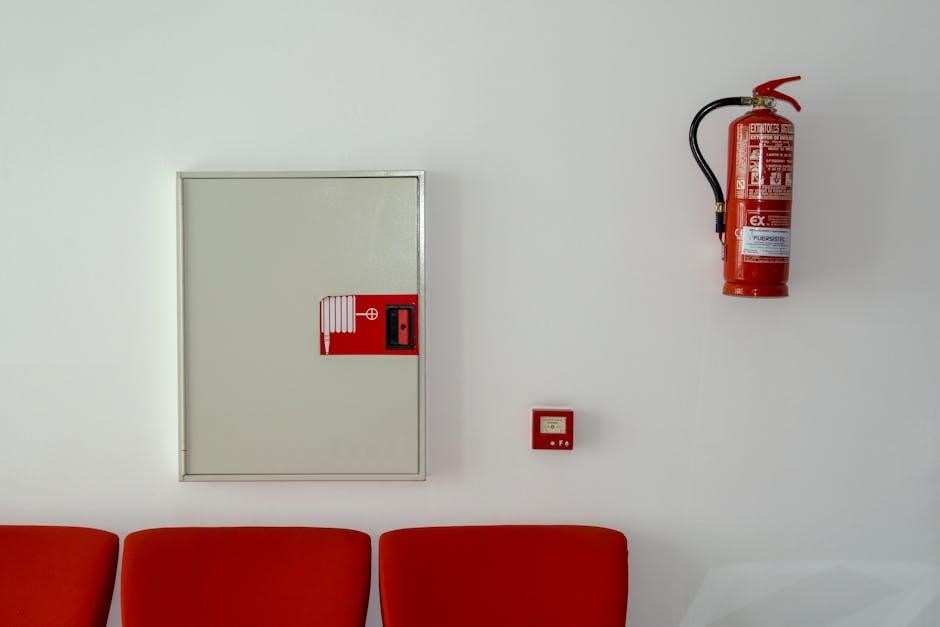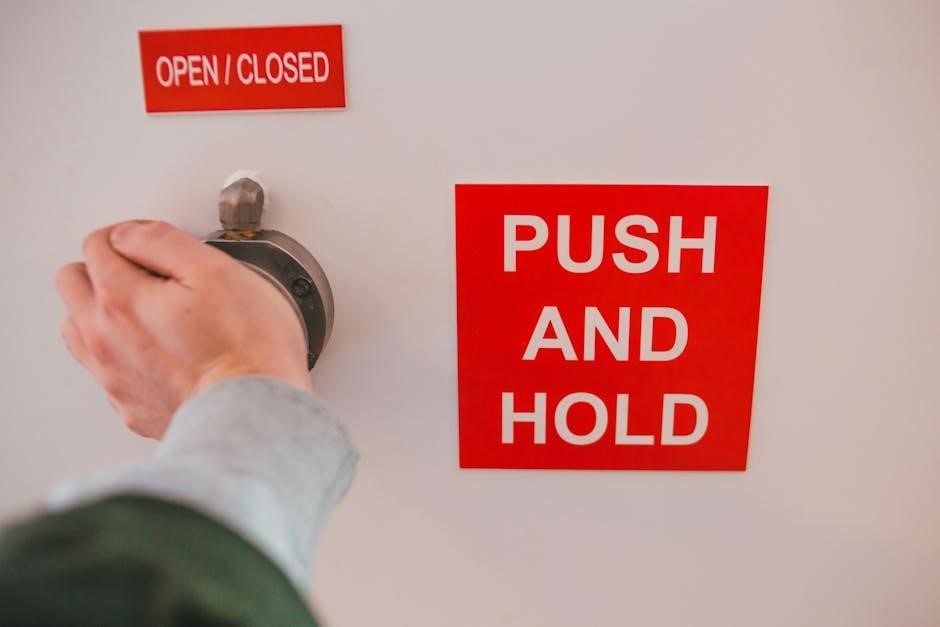Welcome to the First Alert Smoke Alarms manual. This guide introduces you to state-of-the-art smoke alarms designed for early fire detection and enhanced home safety features.
1.1 Overview of First Alert Smoke Alarms
First Alert smoke alarms are renowned for their reliability and innovative features, offering a comprehensive range of models designed to meet various home safety needs. These alarms are equipped with advanced sensors, including photoelectric and ionization technology, to detect smoke and carbon monoxide accurately. Many models feature voice and location alerts, providing clear warnings in emergencies. The Onelink series integrates seamlessly with smart home systems like HomeKit and Alexa, while others offer a traditional, hardwired, or battery-powered setup. With sleek designs and user-friendly interfaces, First Alert smoke alarms ensure early detection and peace of mind. Their compliance with UL standards and long-term durability make them a trusted choice for homeowners seeking reliable fire safety solutions.
1.2 Importance of Smoke Alarms in Home Safety
Smoke alarms are a critical component of home safety systems, providing early detection of fires and potentially life-saving warnings. According to safety experts, working smoke alarms can reduce fire-related deaths by up to 50%. They alert occupants to danger before it escalates, allowing time for evacuation. First Alert smoke alarms are designed to detect both smoke and carbon monoxide, addressing dual threats in the home. Their reliability and advanced features ensure constant vigilance, offering peace of mind for families. Proper installation and maintenance of these devices are essential to maximize their effectiveness and protect against unforeseen hazards. Smoke alarms are not just a safety measure—they are a necessity for every home.

Key Features of First Alert Smoke Alarms
First Alert smoke alarms feature advanced sensors, smart home integration, voice alerts, and sleek designs. They detect smoke and CO, ensuring reliable protection with cutting-edge technology.
2.1 Types of Sensors (Photoelectric and Ionization)
First Alert smoke alarms utilize two types of sensors: photoelectric and ionization. Photoelectric sensors detect larger smoke particles, ideal for smoldering fires, while ionization sensors identify smaller particles from fast-flaming fires. This dual-sensor technology ensures comprehensive detection, enhancing home safety. Photoelectric sensors reduce false alarms from cooking or steam, while ionization sensors provide rapid response to explosive fires. Together, they offer reliable protection against various fire hazards, ensuring early warnings for different fire scenarios. This advanced combination minimizes risks and provides peace of mind for homeowners. Both sensor types are designed to meet regulatory standards, guaranteeing efficient and accurate fire detection.
2.2 Smart Smoke Alarms with HomeKit and Alexa Integration
First Alert offers smart smoke alarms with seamless integration with HomeKit and Alexa, enhancing your home’s safety and convenience. The Onelink Safe & Sound smoke alarm, for instance, supports both HomeKit and Alexa, allowing voice commands and smart home system connectivity. This integration enables voice alerts, remote notifications, and synchronization with other smart devices. Users can receive alerts on their phones and control the alarm through compatible apps. With HomeKit, you can automate responses, while Alexa integration provides hands-free voice control. These features ensure a connected and responsive safety system, making it easier to monitor and manage your home’s safety from anywhere. This advanced integration enhances convenience and peace of mind for homeowners.
2.3 Voice and Location Alerts for Enhanced Safety
First Alert smoke alarms feature advanced voice and location alerts to enhance safety and clarity during emergencies. These alarms are equipped with voice notifications that clearly indicate the type of hazard and its location within the home. For example, the alarm may announce, “Fire detected in the kitchen,” providing immediate and specific information. This feature is particularly beneficial for large households or multi-story homes, where identifying the source of the alarm is crucial. The voice alerts also help individuals with visual impairments or those who may be disoriented during an emergency. By combining voice and location alerts, First Alert ensures a faster and more informed response to potential threats.

Installation and Setup
First Alert smoke alarms require proper installation to ensure optimal performance. Follow the step-by-step guide for placement, mounting, and connecting to power sources for reliable operation.
3.1 Choosing the Right Location for Smoke Alarms
Proper placement of First Alert smoke alarms is crucial for effective fire detection. Install alarms on every level of your home, including inside and outside sleeping areas. Avoid areas near kitchens or bathrooms to minimize false alarms caused by cooking smoke or steam. Alarms should be at least 10 feet away from cooking appliances. For optimal coverage, place alarms in hallways and stairways. Ensure they are mounted on ceilings or walls, following the manufacturer’s guidelines. Additionally, avoid installing alarms near windows, doors, or ducts, as drafts may reduce their sensitivity. Always check local regulations and manufacturer recommendations for specific placement requirements.
3.2 Step-by-Step Installation Guide
Begin by selecting a location for your First Alert smoke alarm, ensuring compliance with local regulations and manufacturer guidelines. Gather tools like a screwdriver and drill. For hardwired models, turn off power at the circuit breaker. Mount the bracket to the ceiling or wall using screws. Attach the alarm to the bracket, ensuring it clicks securely. For battery-powered models, insert the batteries as indicated. Connect any additional wires for smart features. Test the alarm by pressing the test button until it sounds. Finally, label the alarm with its location for easy identification. Refer to the manual for specific model instructions and ensure all connections are secure for reliable operation.

Understanding the Indicators and Alerts
First Alert smoke alarms feature power indicators and blinking lights to signal status. A steady light confirms power, while blinking may indicate an issue or alarm memory.
4.1 Power Indicators and Blinking Lights
First Alert smoke alarms feature power indicators and blinking lights to provide clear status updates. A steady red light confirms the alarm is powered, while blinking patterns signal specific conditions. For instance, a red blinking light every 6 minutes indicates normal operation. If the light blinks rapidly, it may signal an alarm memory or error. These visual cues help users quickly identify the alarm’s status without consulting the manual. Understanding these indicators is crucial for maintaining your smoke alarm system and addressing potential issues promptly. Always refer to the manual for detailed explanations of specific blinking patterns and their meanings to ensure optimal performance and safety.
4.2 Differentiating Between Real Alarms and False Alarms
First Alert smoke alarms are designed to alert you to potential dangers, but false alarms can occur due to non-emergency conditions like steam, cooking smoke, or dust. To distinguish between real and false alarms, note the alarm’s behavior. A real alarm will sound continuously, while a false alarm may be intermittent or can be silenced by pressing the test/silence button. If no smoke is present, check for common causes like humidity or cooking fumes. Never disconnect the battery or remove the alarm, as this compromises safety. Instead, silence the alarm using the test button and ensure the area is clear of non-emergency particles. Regular maintenance, like cleaning the sensor, can reduce false alarms and ensure reliable performance.

Maintenance and Troubleshooting
Regularly clean the smoke alarm with a vacuum to remove dust. Test the alarm monthly and replace batteries annually. Inspect sensors for damage or obstructions. If issues persist, refer to the manual or contact customer support for assistance. Replace the unit if it exceeds its 10-year lifespan for optimal performance and safety.
5.1 Regular Maintenance Tips for Smoke Alarms
Regular maintenance ensures your First Alert smoke alarm functions optimally. Start by vacuuming the alarm monthly to remove dust and debris that may interfere with its sensors. Test the alarm weekly by pressing the test button to confirm it’s working properly. Replace batteries annually or as indicated by low-battery alerts. Inspect the sensors for any damage or obstructions. Replace the entire unit after its 10-year lifespan. Always refer to the manual for specific guidance tailored to your model. If you encounter issues, contact First Alert’s customer support at 1-800-323-9005 for assistance. Proper upkeep ensures reliable fire detection and peace of mind.
5.2 Troubleshooting Common Issues
Addressing common issues with your First Alert smoke alarm ensures uninterrupted protection. If the alarm sounds without a fire, check for false triggers like cooking fumes or steam. Press the hush button to silence it temporarily. For persistent false alarms, clean the sensor with a vacuum or replace the battery. If the power indicator light blinks rapidly, it may signal a malfunction; refer to the manual for specific codes. For smart models, connectivity issues can often be resolved by restarting the router or updating the app. If problems persist, contact First Alert’s customer support at 1-800-323-9005 for further assistance. Always ensure the alarm is installed correctly and free from obstructions.

Smart Home Integration
First Alert smoke alarms seamlessly integrate with smart home systems, including Google Nest and Amazon Alexa, enhancing your home security with voice control and real-time notifications.
6.1 Connecting Smoke Alarms to Smart Home Systems
First Alert smoke alarms are designed to integrate seamlessly with smart home systems, offering enhanced control and monitoring. Compatible with Google Nest and Amazon Alexa, these alarms can be connected via Bluetooth or Wi-Fi, enabling voice commands and real-time notifications. The Onelink app guides users through a straightforward setup process, ensuring devices are linked effortlessly. Once connected, users can monitor their smoke alarms remotely, receive alerts, and customize settings for a tailored experience. This integration enhances home security, providing peace of mind and streamlined control. For detailed instructions, refer to the manual or visit the First Alert website for step-by-step guidance.
6.2 Compatibility with Google Nest and Amazon Alexa
First Alert smoke alarms are fully compatible with Google Nest and Amazon Alexa, offering seamless integration into smart home ecosystems. Through partnerships, these alarms work with existing Google Nest systems, ensuring compatibility and enhanced functionality. Users can control and monitor their smoke alarms using voice commands via Alexa or Google Assistant. This integration allows for real-time notifications, voice alerts, and remote monitoring, enhancing home safety. The Onelink app further simplifies management, enabling users to customize settings and receive updates. With compatibility across major smart home platforms, First Alert smoke alarms provide a unified and convenient solution for modern homes. Refer to the manual for detailed pairing instructions.

Warranty and Support
First Alert smoke alarms are backed by a comprehensive warranty and dedicated customer support. For assistance, contact 1-800-323-9005 or visit firstalert.com for detailed support and resources.
7.1 Warranty Information for First Alert Smoke Alarms
First Alert smoke alarms are backed by a comprehensive warranty, ensuring reliability and customer satisfaction. Most models, including the PRC710V and Onelink series, come with a 10-year limited warranty covering manufacturing defects. The warranty period begins from the date of purchase, provided the product is installed and maintained according to the manual. For warranty claims, customers must register their product and provide proof of purchase. First Alert also offers dedicated customer support to address any concerns or issues. Visit firstalert.com or call 1-800-323-9005 for assistance. Always refer to the manual for specific warranty terms and conditions, as they may vary by model and region.
7.2 Customer Support and Assistance
First Alert provides exceptional customer support to ensure your smoke alarms function optimally. Their dedicated team is available via phone at 1-800-323-9005 to assist with troubleshooting, installation, and warranty inquiries. The official website, firstalert.com, offers resources such as manuals, tutorials, and FAQs to guide users. For hard copies of manuals, customers can request them for a nominal fee by contacting support. Additionally, online support is accessible through the website, allowing users to submit queries or find solutions independently. First Alert’s commitment to customer satisfaction ensures you receive timely and effective assistance, helping you maintain a safe and protected home environment with their smoke alarms.